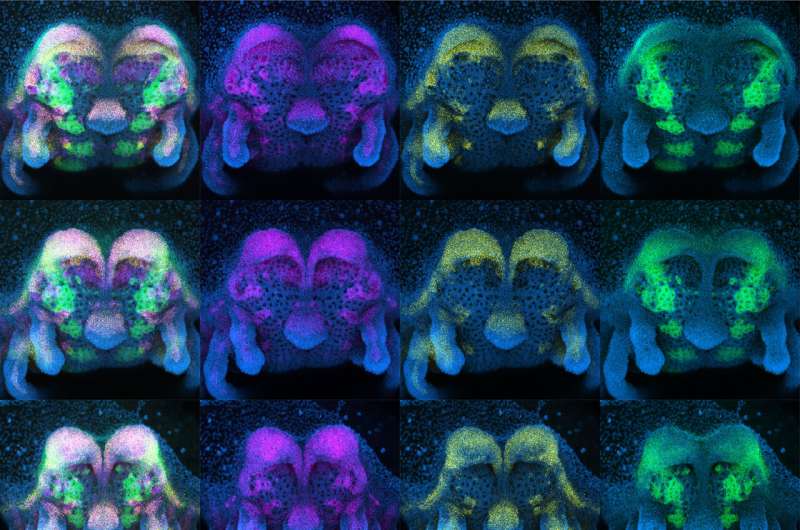This article has been reviewed according to Science X's editorial process and policies. Editors have highlighted the following attributes while ensuring the content's credibility:
fact-checked
peer-reviewed publication
trusted source
proofread
Living species of daddy longlegs has two additional sets of underdeveloped eyes as embryos

While some people may first associate daddy longlegs with, well, their long legs, researchers Guilherme Gainett and Prashant Sharma have been especially focused on the arachnids' eyes. In their paper published last week in the journal Current Biology, the researchers found that a living species of daddy longlegs has two additional sets of underdeveloped eyes as embryos, implying that the species diversified earlier in the evolutionary tree than scientists believed.
The clue to this unexpected discovery lay hidden under the microscope, beside the developing legs of a daddy longlegs.
"I couldn't believe my eyes. It was one of those little moments that happens in science when you see something that no one has ever seen and get really excited," recalls Gainett, who is now a post-doctoral researcher at Boston Children's Hospital and Harvard Medical School.
What Gainett was seeing were opsins, visual proteins that are important for the formation of visual organs and the mechanics of sight. Finding these opsins clustered on the embryos indicated to the researchers that they were likely vestigial eyes, structural remnants that, at another point in evolution, would have developed into two additional sets of lens-bearing, functional eyes.
One set was lateral, located on the side of the head beside the frontmost pair of legs, while the other was a median set, located in front of eyes that appear today on the front of the head. Gainett and Sharma also found evidence that these organs have remained connected to the visual processing part of the brain.
Until now, present-day daddy longlegs were believed to have only one set of median eyes, positioned at the top of the head. While a fossilized specimen of a more ancient version of the arachnid found in 2014 had an additional set of lateral eyes on the side of the head, the new study is the first to show evidence of more than one eye set in a living daddy longlegs species.
Vestigial organs have been of interest to scientists since Charles Darwin began discussing his ideas of evolution.
"They leave these footprints behind in the crime scene of what happened in the transition from one morphology to the other in different groups," Gainett says.
He explains that vestigial organs are important because they can link the ancient and modern traits of species, allowing us to track the evolutionary process as a species gains or—as with this case—loses features over time. Interestingly, the position of the vestigial eyes found in living daddy longlegs are similar to what was reported in the fossilized specimen.

Different eyes have different functions, Gainett explained. Median eyes usually have better visual acuity, so they're better at forming crisp images in some arachnids. Lateral eyes are helpful for detecting movement and light in general, not so much for producing clear images, making them helpful in low-light conditions.
But since the lateral eyes Gainett found on the daddy longlegs embryos don't have lenses, they aren't processing visual information into images in the same way that fully developed eyes do. Instead, Gainett and Sharma believe these eyes are picking up on more general information to help the arachnid tell the difference between light and dark.
Once they discovered the vestigial opsins, Gainett and Sharma began to wonder why and how the daddy longlegs' ancestor lost two pairs of eyes. It's difficult to know what environmental conditions could have played a roll, so instead they looked to the genetic and developmental conditions that give rise to different kinds of eyes.
Gainett and Sharma studied a group of genes that code for the development of arachnid eyes.
"Some of these genes are expressed in both types of eyes, so they're necessary for all eyes, for median eyes and lateral eyes. But some of these genes are more restricted to one type or another," says Gainett.
By experimenting with "knocking down" genes' expressions, they were able to provide evidence that the vestigial organs were likely eyes. Gainett explains knocking down genes as a temporary way to dim down their expression, rather than permanently switching them off entirely.
To dim the expression of genes responsible for eye development, the researchers used a process called RNA interference. It essentially tricks a cell into thinking its own gene is a threat and, like a virus, should be chopped up so it can't be duplicated. When the expression of these genes was lowered in daddy longlegs embryos, the individuals did not develop eyes.
Drawing these genetic and developmental links between the vestigial eyes of a present-day daddy longlegs and the fossilized specimen gives an important look inside how evolution happens.
"One of the goals of studying the genetics behind what we see in morphology is really understanding how evolution happens. What do you need to change in the underlying recipe of genes for the diversity of eyes to evolve?" Gainett explains.
More information: Guilherme Gainett et al, Vestigial organs alter fossil placements in an ancient group of terrestrial chelicerates, Current Biology (2024). DOI: 10.1016/j.cub.2024.02.011
Journal information: Current Biology
Provided by University of Wisconsin-Madison





















